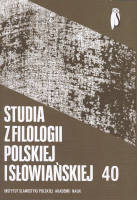Praindoeuropejskie i nostratyckie źródła do rekonstrukcji form kategorii osoby w językach słowiańskich
The Indo-European and Nostratic Sources for the Reconstruction of the Category of the Person in the Slavic Languages
Author(s): Włodzimierz PiankaSubject(s): Language and Literature Studies
Published by: Instytut Slawistyki Polskiej Akademii Nauk
Summary/Abstract: The purpose of this paper is a reconstruction of the Indo-European pronouns through a developing and completing of the reconstruction done by V. M. Illič-Svityč (Opyt sravnenija nostratič eskih jazykov[...], Moscow 97 ). The Author of this paper adopts the existing of the following forms of the Proto-Indo-European pronoun morphems: the st pers.: sing. – nominal me and verbal: +m, +mi, +meF/+moF, coll.: nominal ne and verbal: +me/+mo, +mes/+mos; the 2nd pers.: sing. – nominal te and verbal: +t, +ti, +teF/+toF, coll.: nominal Ge and verbal: +te, +tes; the 3rd pers. sing. and coll. – nominal: se (rationalia) and te (irrationalia), verbal: sing. +s, +si, +seF /+soF, coll. -o-nt – a participle form (similar to that in Finnish languges) and he forms his ideas: 1. In any part of the Nostratic languages (including any part of the Indo- -European languages) the opposition se : te was neutralized, what caused: a) the turn of the initial vowel of the adjective pronoun with the form of the nominative singular sos m, sâ f < *se (primary pronoun for the 3rd person) under the influence of tod n < *te (the forms in the nominative with s- are preserved in the Oldindian, Avesta, Gotian languages and reconstructed in Greek); in the Old-Church-Slavic exists the demonstrative pronoun t., ta, to (retainted relictly as the personal pronoun), b) the turn of the Function of the pronoun of the 3rd Person with the genitive form (sing.) se-Ge (secondary in proportion to the genitive form (sing.) te-Ge of the 2. sing. te), where the second element was the pronoun for the 2nd person like in the genitive from me: me-ne), which became the reflexive pronoun, at first for the 3rd pers. sing. and pl. (cf. the trace e. g. German sich, currently the form of the accusative (and secundary the dative sing. and pl.) as a reflexive, was otherwise in the st and 2nd person sing. and pl. expresses the personal pronoun) and later in the st and 2nd person sing. and pl. (and du.) too. Włodzimierz Pianka 2. In the time, when the pronoun t- in the Indo-European functioned as the pronoun for the 3rd person sing. and pl. (rationalia + irrationalia), the verbal endings for the 3rd person sing. with +s-, according to the parallelism of the verbal morphems to the nominal morphems, where replaced with the endings with +t (a influence of the morphem of the 3rd person pl. on the form for sing. is possible). This primitive state ist preserved in the Tocharian, Hittite and Phrygian languages. 3. The old endigs of the 3rd pers. sing. with +s were introduced into the 2nd pers. sing., the syncretism to avoid. This is known, that the both of endings are found in the form of the 2nd person sing. (Germ. . bin, 2. bist, 3. ist).
Journal: Studia z Filologii Polskiej i Słowiańskiej
- Issue Year: 2005
- Issue No: 40
- Page Range: 399-420
- Page Count: 20
- Language: Polish

